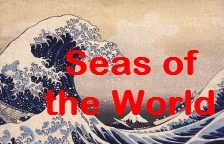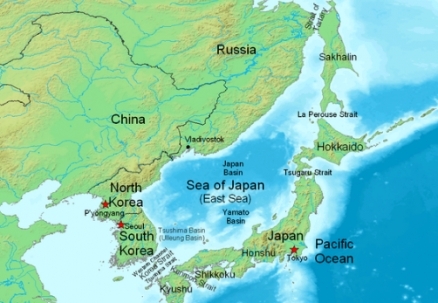Sea of Japan
Seas of the World  The Sea of Japan (also East Sea) is a marginal sea of the western Pacific Ocean between the coasts of Korea (North and South) and Russia on the Asia mainland and the islands of Japan.
The Sea of Japan (also East Sea) is a marginal sea of the western Pacific Ocean between the coasts of Korea (North and South) and Russia on the Asia mainland and the islands of Japan.
It is considered a mediterranean sea, since its perimeter is almost completely enclosed by land. Moreover, in the early Miocene the present sea was virtually entirely enclosed, when orogenic and tectonic forces began to create more well defined channels to the Pacific, such processes continuing substantively into the Pliocene.
| This article is written at a definitional level only. Authors wishing to improve this entry are inivited to expand the present treatment, which additions will be peer reviewed prior to publication of any expansion. |
The Sea of Japan is noted for salinity slightly below the average of the seas of the world, very low tidal action and and low influxes of riverine inflow from the Asian mainland as well as Japan.
Geography and limits
To the north of the Sea of Japan is the Asian mainland of Russia and North Korea, with the mainland of South Korea lying to the west. Bounding the south and east of the Sea of Japan is the Japanese Archipelago.
The Sea of Japan has an area of approximately 978,000 square kilometers (km2), a volume of 1,713,000 cubic kilometers (km3), and a mean depth of 1,350 meters (m).
The Sea of Japan is connected to the Sea of Okhotsk, the Northern Pacific Ocean and the East China Sea through five shallow straits. From south to north, these are:
- The Strait of Korea separating the southernmost Japanese island of Kyushu from the mainland of South Korea and connecting to the East China Sea. This strait substantially opened as late as the Neogene, halting the migration of land mammals such as elephants onto the Japanese islands. In the middle of the Korea Strait is the island of Tsushima (Japan). The passage northeast of Tsushima Island is known as the Western Channel while the passage southwest of Tsushima Island is known as the Tsushima Strait.
- The Kanmon Strait between the Japanese islands of Kyushu and Honshu connecting to the Seto Inland Sea and beyond it to the Pacific Ocean
- The Tsugaru Strait between the Japanese islands of Honshu and Hokkaido connecting to the Pacific Ocean.
- La Perouse Strait (also Soya Strait) between the Japanese island of Hokkaido and the Russian island of Sakhalin connecting to the south of the Sea of Okhotsk
- The Strait of Tartary between the Russian mainland and the island of Sakhalin connecting to the eastern part of the Sea of Okhotsk. The world's tenth largest river, the Amur River drains to the Strait of Tartary.
The Tsushima Current, a small branch of the warm Kuroshio Current, enters the Sea of Japan through the Tsushima Strait between Kyushu and Korea and flows out to the Pacific through the Tsugaru and La Perouse/Soya Straits.
Ecology
See: Sea of Japan large marine ecosystem
References
- International Hydrographic Organization. 1953. Limits of Oceans and Seas, 3rd edition.
- S.-C.Park, Yoo, D.-G., Lee, C.-W., Lee, E.-I. (26 September 2000). Last glacial sea-level changes and paleogeography of the Korea (Tsushima) Strait. Geo-Marine Letters 20 (2): 64–71.
- W.J.Teague, G.A.Jacobs, H.T.Perkins, J.W.Book, K.-I.Chang, M.-S.Suk. 2001. Low-Frequency Current Observations in the Korea/Tsushima Strait. Journal of Physical Oceanography 32, 1621–1641.
See also
- Sea of Okhotsk
- Seas of the world on the Encyclopedia of Earth
